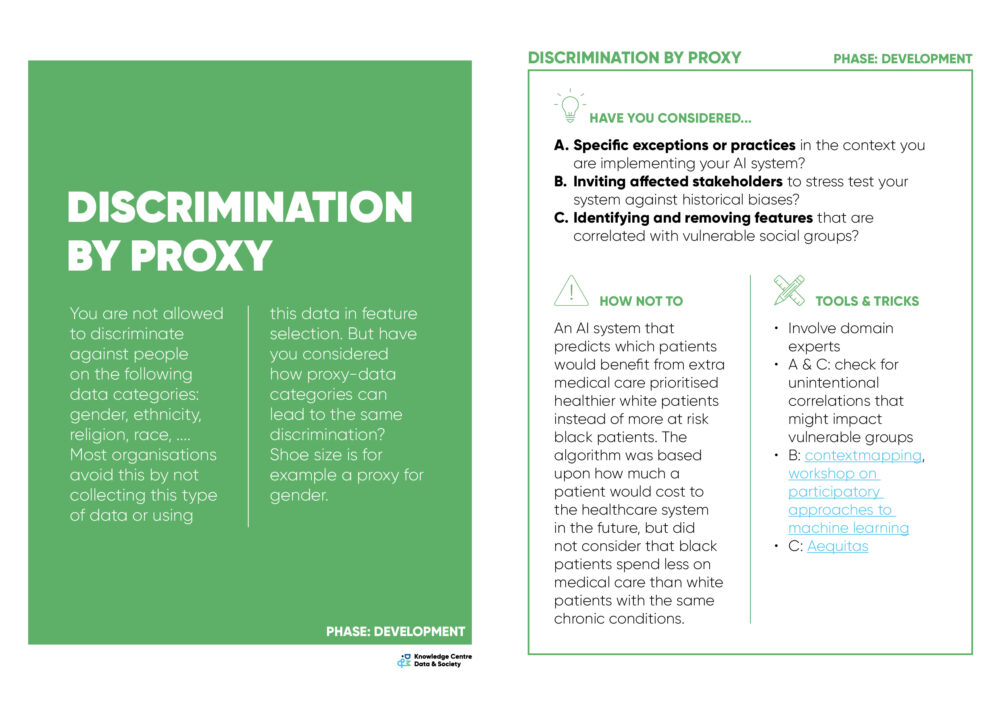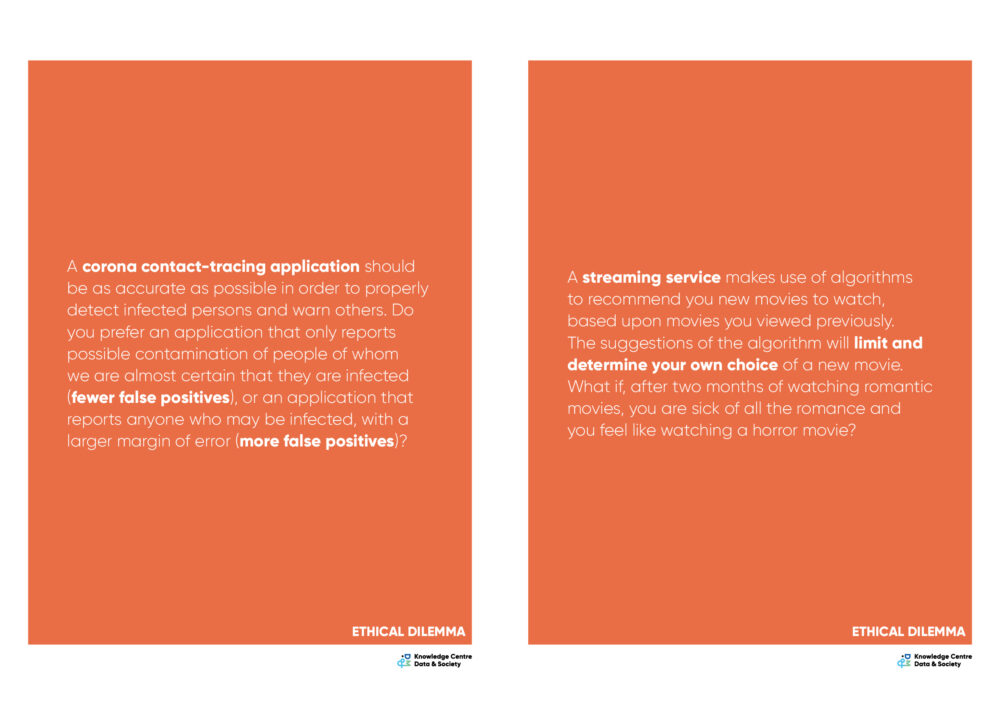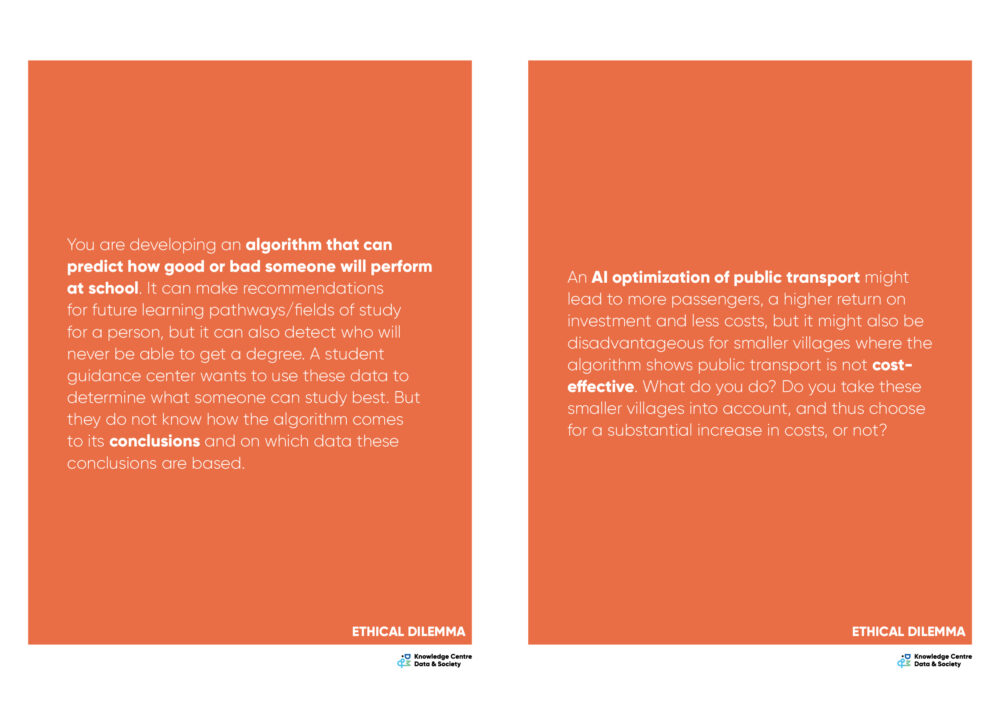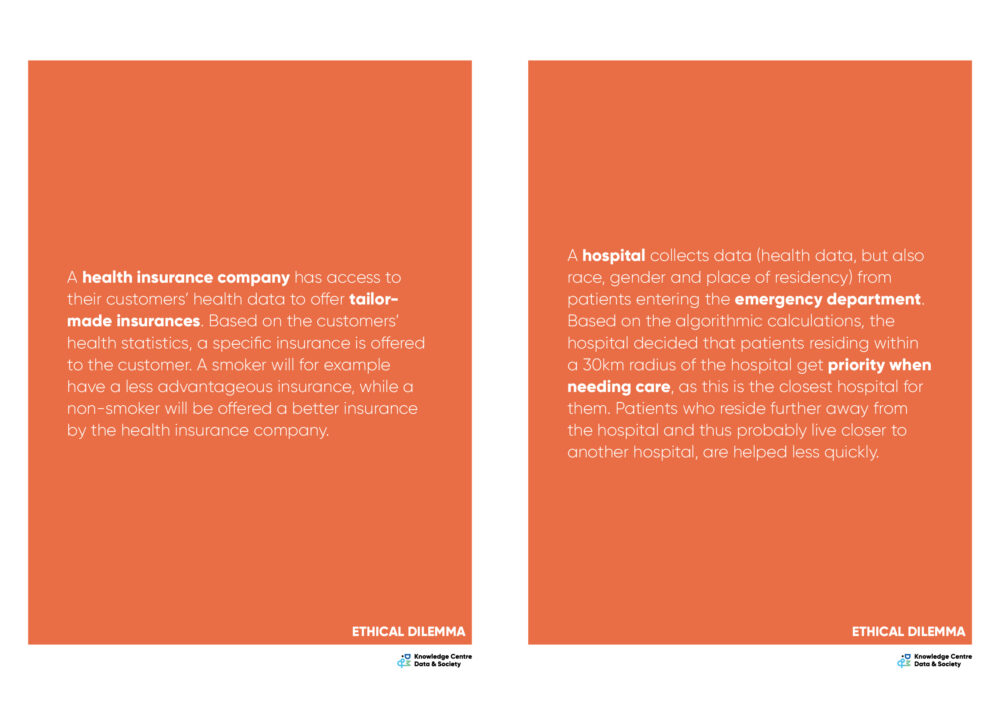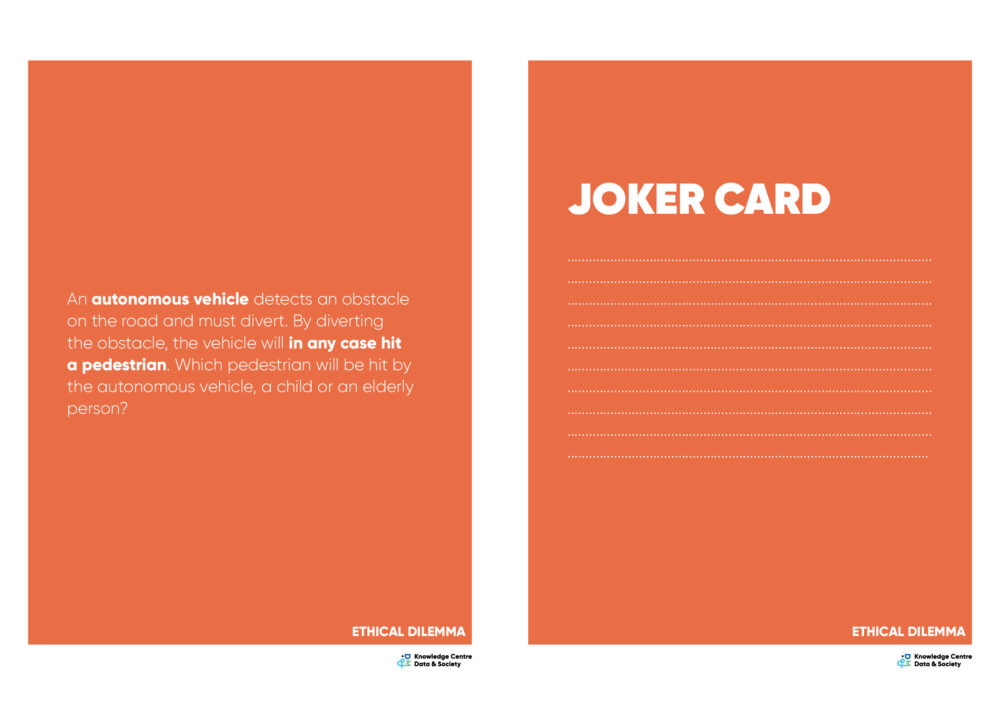AI Blindspots card set 2.0
How
can you take into account possible prejudices and structural
inequalities before, during and after the development of an AI system? In
order to help you do this, the Knowledge Centre Data & Society
developed the AI Blindspots card set to uncover potential AI
blindspots by reflecting on decisions and actions prior to the
development of your AI system.
The mindset you and your team have when creating a new AI application is one of improvement: in order to succeed, you have to be convinced that you are creating a (better) solution for a problem. For that reason, it is usually difficult to also consider negative consequences of your AI application. With the AI Blindspots card set we make you aware of 'Blindspots' - ethical pitfalls - in AI innovations, so that you can further improve your AI application while addressing potential negative side-effects of your application.
What you should know before reading further
- Target group: business, policy and civil society organisations
- Project phase: problem analysis/ideation, model design, development, implementation, evaluation/iteration
- Systeem component: entire application and users
- Price: freely available
- Language: English (Dutch translation will come soon)
Why would u use the card set?
The card set can help you and your team to...
- create a culture of ethical and societal awareness;
- identify challenges before they cause harm;
- improve the overall quality and acceptability of your product;
- communicate with your stakeholders on how you coped with the ethical, societal and legal impact of your product.
How does the card set look like?
The card set contains two card types:
- The AI Blindspots cards are divided into three phases, i.e. the planning phase, the development phase and the implementation phase. Each card presents one blindspot and contains:
- A set of questions to help you uncover this blindspot;
- A use case that illustrates the importance of considering the blindspot;
- A number of tools and tricks to help you detect and mitigate the blindspot.
- A set of questions to help you uncover this blindspot;
- The Ethische Dilemma cards are examples of situations in which an ethical issue arises.
How can you use the card set?
Below you can find an overview of six methods to use the AI Blindspots card set in your company/organisation.
As a conversation starter:
- A conversation starter for you and your company to discuss the ethical, legal and societal aspects of AI technologies.
During a workshop:
- A workshop with your team wherein you focus on one Ethical Dilemma card of your choosing and try to come up with one or several solutions for that particular dilemma. In a later stage, you look at the AI Blindspots cards and see if you can think of other solutions or make one of the already identified solutions more concrete with the help of the cards. > template available (see downloads)
- A workshop with your team wherein you divide the group into three subgroups. Each one of the groups will look at a different phase of the AI Blindspots cards. You pick one Ethical Dilemma card and each group can think about how to solve the dilemma with the help of their AI Blindspots cards.
- A workshop with your team wherein you identify one of your own Ethical Dilemmas and write it on the Ethical Dilemma joker card. Next, you can jointly think of one or several solutions with the help of the AI Blindspots cards. > template available (see downloads)
- A workshop with your team wherein you create requirements for your innovation using a reverse brainstorm. A reverse brainstorm does not aim to solve a problem but rather to make the problem bigger. Use the AI Blindspots cards and ask yourself: “How can we ensure to make this blindspot a reality for our innovation?”. After the reversed brainstorm, reverse these unethical measures into requirements for your innovation. > template available (see downloads)
As an evaluation tool:
- A double check for you and your team when you are designing, developing or implementing an AI system. Look at the AI Blindspots cards and see if you took into account the possible blindspots. If not, discuss how you and your team will deal with the blindspots.
Planning phase
The AI Blindspots cards are divided into three phases, corresponding to the three major phases in a project with and/or the development process of data applications and AI systems. These phases are the planning, development and implementation phase. The planning phase is the first phase, prior to the development of the data application or the AI system, in which the purpose, the target group, the usefulness, etc. of the technology is determined. For the planning phase, we identified the following AI Blindspots:
Click on a blindspot if you want to know more about how you can identify and detect/mitigate it.
Development phase
The development phase is the second phase in which you already have a clear goal and a target group in mind for your data application or AI system. But now, it comes down to the elaboration of your data application or AI system. For the development phase we identified the following AI Blindspots:
Click on a blindspot if you want to know more about how you can identify and detect/mitigate it.
Implementation phase
Finally, you have the implementation phase in which you finalize and market your data application or AI system and/or launch your project in which an AI component is present. Which AI Blindspots should you take into account in this phase? For the implementation phase we identified the following AI Blindspots:
- Generalization error
- Right to explanation/objection
- User manual
- Transparency
- Service reconsideration
- Accountability & sign-off
- Revisited purpose
- Perverse effects
Click on a blindspot if you want to know more about how you can identify and detect/mitigate it.
Ethical dilemmas
Downloads
And now...?
- Download the AI Blindspots card set and get started.
- Download the PDF below with 2 templates to use the AI Blindspots card set. With the first template, you start from an ethical dilemma and use the AI Blindspots cards (workshop method 1 and 2). The second template can be used for a reversed brainstorm with the AI Blindspots card set (workshop method 4). To give you an example of how you can use the templates, the PDF includes a completed template.
This card set is inspired by AI Blindspot of Ania Calderon, Dan Taber, Hong Qu, and Jeff Wen, developed during the Berkman Klein Center and MIT Media Lab’s 2019 Assembly program. The AI Blindspots card set is available under a CC BY 4.0 Licence.
The Knowledge Centre Data & Society adapted the original card set to the Flemish context in order to support the development of trustworthy AI in Flanders.

